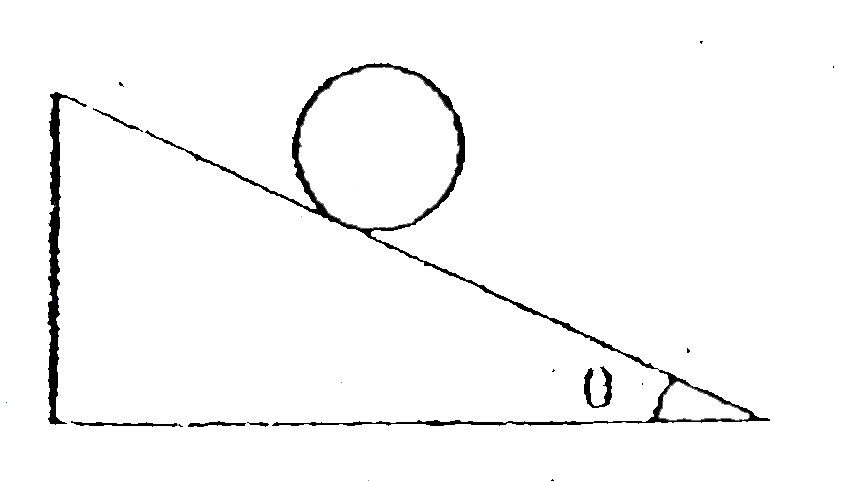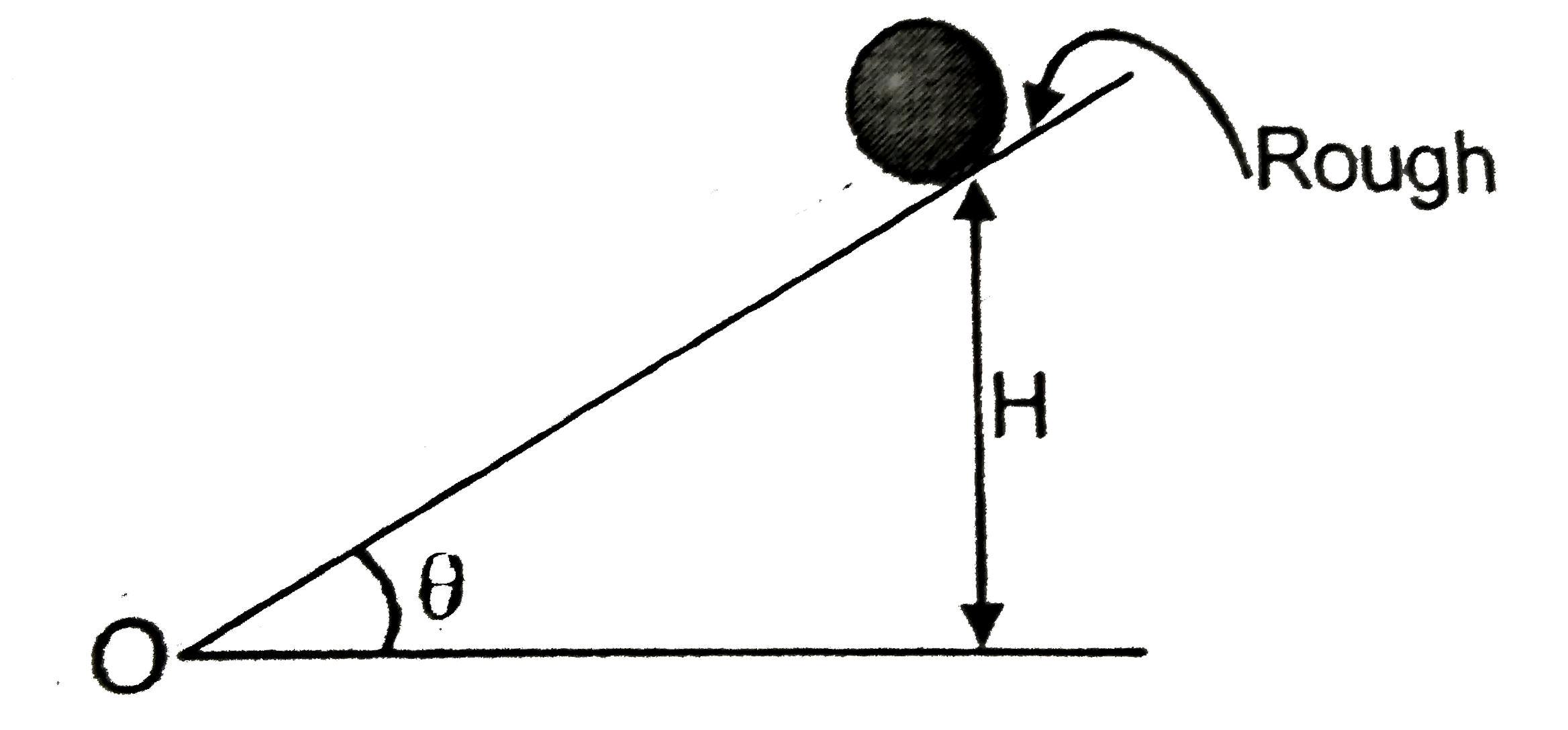Two identical solid cylinders are released from the top of two inclined planes of equal angles. If one cylinder is in pure rolling and other is in pure sliding motion then
The sliding cylinder will reach the bottom later with lower speed
The rolling cylinder will reach the bottom later with lower speed
Both reach the bottom simultaneously with different speed
Both reach the bottom simultaneously with same speed
To solve the problem step by step, we need to analyze the motion of both cylinders on the inclined planes.
Step 1: Understand the Setup
We have two identical solid cylinders released from the top of two inclined planes of equal angles. One cylinder is in pure rolling motion, while the other is in pure sliding motion.
Step 2: Analyze the Sliding Cylinder
For the cylinder that is sliding down the incline:
- The forces acting on it are:
- Gravitational force mg acting downward.
- Normal force N acting perpendicular to the incline.
- The component of gravitational force acting down the incline is:
Fdown=mgsinθ
- The component of gravitational force acting perpendicular to the incline is:
Fnormal=mgcosθ
- Since there is no friction acting on the sliding cylinder, we can use Newton's second law:
mgsinθ=ma
where a is the acceleration of the sliding cylinder.
- Rearranging gives:
a=gsinθ
Step 3: Analyze the Rolling Cylinder
For the cylinder that is rolling down the incline:
- The forces acting on it are similar, but we also have friction acting at the point of contact, which prevents slipping.
- The equation of motion for the rolling cylinder can be written as:
mgsinθ−f=ma′
where f is the frictional force and a′ is the acceleration of the rolling cylinder.
- The torque due to friction about the center of mass is given by:
τ=Iα
where I is the moment of inertia and α is the angular acceleration.
- For a solid cylinder, the moment of inertia I is:
I=12mr2
- The relationship between linear acceleration a′ and angular acceleration α is:
a′=rα
- The torque equation becomes:
f⋅r=12mr2⋅a′r
Simplifying gives:
f=12ma′
Step 4: Combine the Equations for the Rolling Cylinder
Substituting the expression for friction f into the equation of motion for the rolling cylinder:
mgsinθ−12ma′=ma′
Rearranging gives:
mgsinθ=32ma′
Thus, we find:
a′=23gsinθ
Step 5: Compare Accelerations
Now we have the accelerations for both cylinders:
- For the sliding cylinder: a=gsinθ
- For the rolling cylinder: a′=23gsinθ
Conclusion
Since a′<a, the sliding cylinder has a greater acceleration and will reach the bottom of the incline first.
Final Answer
The sliding cylinder reaches the bottom first, while the rolling cylinder reaches later.
---
We have two identical solid cylinders released from the top of two inclined planes of equal angles. One cylinder is in pure rolling motion, while the other is in pure sliding motion.
For the cylinder that is sliding down the incline:
- The forces acting on it are:
- Gravitational force mg acting downward.
- Normal force N acting perpendicular to the incline.
- The component of gravitational force acting down the incline is:
Fdown=mgsinθ
- The component of gravitational force acting perpendicular to the incline is:
Fnormal=mgcosθ
mgsinθ=ma
where a is the acceleration of the sliding cylinder.
a=gsinθ
For the cylinder that is rolling down the incline:
- The forces acting on it are similar, but we also have friction acting at the point of contact, which prevents slipping.
- The equation of motion for the rolling cylinder can be written as:
mgsinθ−f=ma′
where f is the frictional force and a′ is the acceleration of the rolling cylinder.
τ=Iα
where I is the moment of inertia and α is the angular acceleration.
I=12mr2
a′=rα
f⋅r=12mr2⋅a′r
Simplifying gives:
f=12ma′
Substituting the expression for friction f into the equation of motion for the rolling cylinder:
mgsinθ−12ma′=ma′
Rearranging gives:
mgsinθ=32ma′
Thus, we find:
a′=23gsinθ
Now we have the accelerations for both cylinders:
- For the sliding cylinder: a=gsinθ
- For the rolling cylinder: a′=23gsinθ
Since a′<a, the sliding cylinder has a greater acceleration and will reach the bottom of the incline first.
The sliding cylinder reaches the bottom first, while the rolling cylinder reaches later.
Topper's Solved these Questions
Similar Questions
A solid cylinder is rolling down a rough inclined plane of inclination θ. Then
View SolutionA solid sphere is in pure rolling motion on an inclined surface having inclination θ
View SolutionTwo objects, a ring and a spherical shell of same mass and radius are released from the top of two Identical inclined plane. If they are rolling without slipping, then ratio of speed of center of mass of the two objects when they will reach the bottom of the inclined plane is
View SolutionA solid cylinder and a solid sphere, both having the same mass and radius, are released from a rough inclined plane of inclination θ one by one. They roll on the inclined plane without slipping. The force of friction that acts
View SolutionA cylinder is released from rest from the top of an incline of inclination θ and length 'L'. If the cylinder rolls without slipping. What will be its speed when it reaches the bottom?
View SolutionA solid cylinder is rolling down the inclined plane without slipping. Which of the following is correct?

View SolutionA ring, a solid cylinder, a hollow sphere and a solid sphere are released from rest on an inclined plane from same level. If there is no slipping then which one of these will reach the ground at last?
View SolutionA solid ball of mass 'm' is released on a rough fixed inclined plane from height H. The ball will perform pure rolling on the inclined plane. Then

View SolutionA cylinder rolls down two different inclined planes of the same height but of different inclinations
View SolutionA hollow sphere is released from top of an inclined plane of inclination 30º and length of inclined plane is /. If sphere rolls without slipping then its speed at bottom is
View Solution
